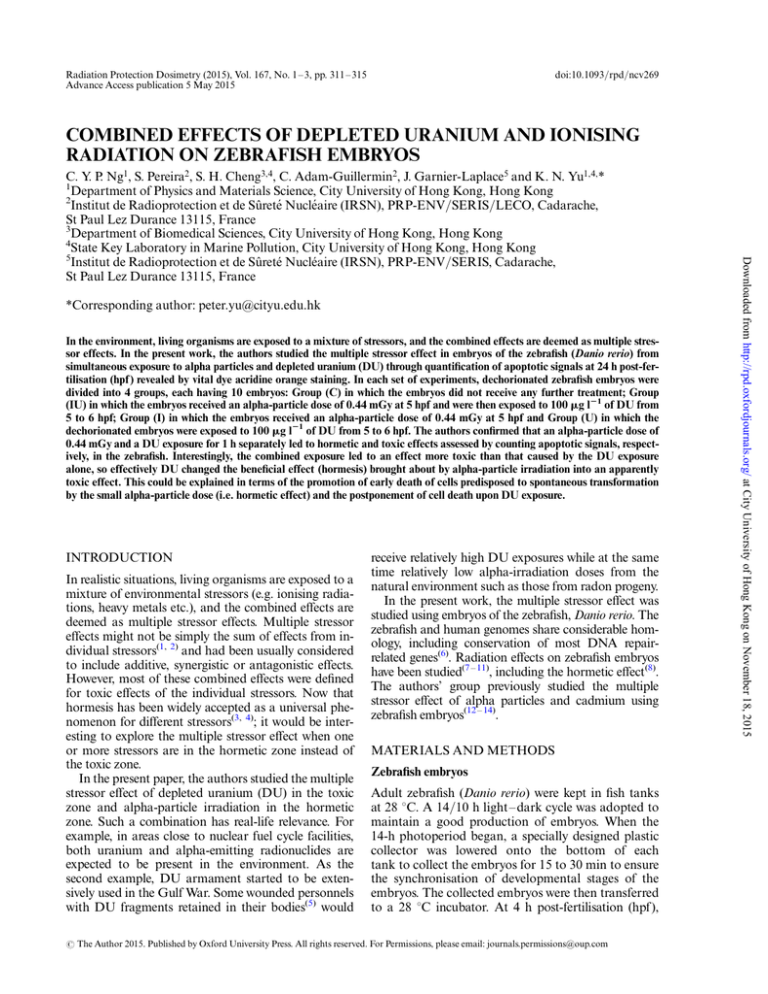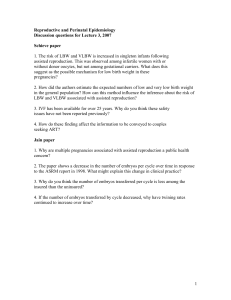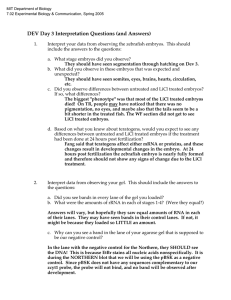
Radiation Protection Dosimetry (2015), Vol. 167, No. 1–3, pp. 311 –315
Advance Access publication 5 May 2015
doi:10.1093/rpd/ncv269
COMBINED EFFECTS OF DEPLETED URANIUM AND IONISING
RADIATION ON ZEBRAFISH EMBRYOS
*Corresponding author: peter.yu@cityu.edu.hk
In the environment, living organisms are exposed to a mixture of stressors, and the combined effects are deemed as multiple stressor effects. In the present work, the authors studied the multiple stressor effect in embryos of the zebrafish (Danio rerio) from
simultaneous exposure to alpha particles and depleted uranium (DU) through quantification of apoptotic signals at 24 h post-fertilisation (hpf) revealed by vital dye acridine orange staining. In each set of experiments, dechorionated zebrafish embryos were
divided into 4 groups, each having 10 embryos: Group (C) in which the embryos did not receive any further treatment; Group
(IU) in which the embryos received an alpha-particle dose of 0.44 mGy at 5 hpf and were then exposed to 100 mg l21 of DU from
5 to 6 hpf; Group (I) in which the embryos received an alpha-particle dose of 0.44 mGy at 5 hpf and Group (U) in which the
dechorionated embryos were exposed to 100 mg l21 of DU from 5 to 6 hpf. The authors confirmed that an alpha-particle dose of
0.44 mGy and a DU exposure for 1 h separately led to hormetic and toxic effects assessed by counting apoptotic signals, respectively, in the zebrafish. Interestingly, the combined exposure led to an effect more toxic than that caused by the DU exposure
alone, so effectively DU changed the beneficial effect (hormesis) brought about by alpha-particle irradiation into an apparently
toxic effect. This could be explained in terms of the promotion of early death of cells predisposed to spontaneous transformation
by the small alpha-particle dose (i.e. hormetic effect) and the postponement of cell death upon DU exposure.
INTRODUCTION
In realistic situations, living organisms are exposed to a
mixture of environmental stressors (e.g. ionising radiations, heavy metals etc.), and the combined effects are
deemed as multiple stressor effects. Multiple stressor
effects might not be simply the sum of effects from individual stressors(1, 2) and had been usually considered
to include additive, synergistic or antagonistic effects.
However, most of these combined effects were defined
for toxic effects of the individual stressors. Now that
hormesis has been widely accepted as a universal phenomenon for different stressors(3, 4); it would be interesting to explore the multiple stressor effect when one
or more stressors are in the hormetic zone instead of
the toxic zone.
In the present paper, the authors studied the multiple
stressor effect of depleted uranium (DU) in the toxic
zone and alpha-particle irradiation in the hormetic
zone. Such a combination has real-life relevance. For
example, in areas close to nuclear fuel cycle facilities,
both uranium and alpha-emitting radionuclides are
expected to be present in the environment. As the
second example, DU armament started to be extensively used in the Gulf War. Some wounded personnels
with DU fragments retained in their bodies(5) would
receive relatively high DU exposures while at the same
time relatively low alpha-irradiation doses from the
natural environment such as those from radon progeny.
In the present work, the multiple stressor effect was
studied using embryos of the zebrafish, Danio rerio. The
zebrafish and human genomes share considerable homology, including conservation of most DNA repairrelated genes(6). Radiation effects on zebrafish embryos
have been studied(7 – 11), including the hormetic effect(8).
The authors’ group previously studied the multiple
stressor effect of alpha particles and cadmium using
zebrafish embryos(12 – 14).
MATERIALS AND METHODS
Zebrafish embryos
Adult zebrafish (Danio rerio) were kept in fish tanks
at 28 8C. A 14/10 h light –dark cycle was adopted to
maintain a good production of embryos. When the
14-h photoperiod began, a specially designed plastic
collector was lowered onto the bottom of each
tank to collect the embryos for 15 to 30 min to ensure
the synchronisation of developmental stages of the
embryos. The collected embryos were then transferred
to a 28 8C incubator. At 4 h post-fertilisation (hpf),
# The Author 2015. Published by Oxford University Press. All rights reserved. For Permissions, please email: journals.permissions@oup.com
Downloaded from http://rpd.oxfordjournals.org/ at City University of Hong Kong on November 18, 2015
C. Y. P. Ng1, S. Pereira2, S. H. Cheng3,4, C. Adam-Guillermin2, J. Garnier-Laplace5 and K. N. Yu1,4,*
1
Department of Physics and Materials Science, City University of Hong Kong, Hong Kong
2
Institut de Radioprotection et de Sûreté Nucléaire (IRSN), PRP-ENV/SERIS/LECO, Cadarache,
St Paul Lez Durance 13115, France
3
Department of Biomedical Sciences, City University of Hong Kong, Hong Kong
4
State Key Laboratory in Marine Pollution, City University of Hong Kong, Hong Kong
5
Institut de Radioprotection et de Sûreté Nucléaire (IRSN), PRP-ENV/SERIS, Cadarache,
St Paul Lez Durance 13115, France
C. Y. P. NG ET AL.
healthy developing embryos at the sphere stage of the
blastula period were selected under a stereomicroscope
and transferred into a Petri dish lined with agarose gel
on the bottom and filled with E3 medium (5 mM NaCl,
0.17 mM KCl, 0.33 mM CaCl2, 0.33 mM MgSO4 and
0.1 % methylene blue) to facilitate dechorionation.
Grouping of zebrafish embryos
(1) Control group (C): in which the dechorionated
embryos did not receive any further treatment;
(2) Alpha-particle-irradiated and DU-dosed group
(IU): in which the dechorionated embryos received
an alpha-particle dose of 0.44 mGy at 5 hpf and
were then exposed to 100 mg l21 of DU for 1 h
(from 5 to 6 hpf);
(3) Irradiated group (I): in which the dechorionated
embryos received an alpha-particle dose of 0.44
mGy at 5 hpf;
The experimental flow involving embryos in these
four groups is schematically shown in Figure 1. The
experiments were repeated three times. As described
earlier, 40 dechorionated embryos were employed for
each replicate. In each Petri dish, 3 ml of medium was
used. The embryos in Groups I and U were exposed
to alpha particles and DU, respectively, whereas those
in Group IU were exposed first to alpha particles and
then to DU.
Alpha-particle irradiation
Alpha-particle irradiation of zebrafish embryos was
performed with the set-up described by Yum et al.(7)
The irradiation dish was a Petri dish with a 35-mmdiameter hole at the centre covered by a 3.5-mm-thick
biocompatible Mylar film (Dupont, Hong Kong) substrate, which was fixed to the dish using an epoxy
(Araldite Rapid, England). An 241Am source emitting
alpha particles with an energy of 5.49 MeV under
vacuum and an activity of 4.26 kBq was employed.
Figure 1. The experimental flow involving embryos in the control group (C), alpha-particle irradiated and DU-dosed group
(IU), irradiated group (I) and DU-dosed group (U).
312
Downloaded from http://rpd.oxfordjournals.org/ at City University of Hong Kong on November 18, 2015
In each set of experiments, the dechorionated zebrafish embryos were divided into four groups, each
having 10 embryos, and accommodated in four separate Petri dishes lined with agarose on the bottom. The
four groups were referred to as:
(4) DU-dosed group (U): in which the dechorionated
embryos were exposed to 100 mg l21 of DU for
1 h (from 5 to 6 hpf ).
DEPLETED URANIUM AND IONISING RADIATION
Depleted uranium exposure
In the present project, DU exposure was provided
by uranyl acetate [UA, UO2(CH3COO)2†2H2O]
(Electron Microscopy Sciences). For each set of
experiments, a new DU stock solution was prepared
to avoid the fluctuation in the DU concentration due
to precipitation. To ensure UA was completely dissolved, preparation of the stock solution started 1 d
before performing each set of experiments. The UA
stock solution with a DU concentration 0.15–0.30 g l21
was prepared by dissolving UA with MilliQ water.
Since UA was sensitive to light and would precipitate
if exposed, all stock solution was kept at 4 8C and in
dark. On the day of the experiment, the stock solution
was further diluted to the desired concentration of
100 mg l21 of DU. A volume of 3 ml of UA working
solution, which was sufficient to cover all embryos in
each dish, was prepared in two new Petri dishes.
Immediately after the IU and U groups of embryos
were irradiated and sham-irradiated with alpha particles, respectively, they were removed from the original
medium and transferred into the UA solution carefully with a glass dropper to provide the DU exposure.
The embryos were kept in the UA solution for 1 h in
dark. After 1 h, the embryos were removed from the
UA solution, washed with 6 ml of clean medium and
finally transferred to new Petri dishes with 3 ml of
clean medium. All four groups of embryos (C, IU, I
and U) were then returned to the 28 8C incubator for
further development.
containing 2 mg ml21 of the vital dye acridine orange
(AO) (Sigma, St. Louis, MO, USA), which was commonly used to quantify the level of apoptosis in zebrafish embryos(15 – 17), to stain in the dark for 60 min
and then thoroughly washed twice in the culture
medium. After anaesthetizing the embryos by 0.0016 M
tricaine (Sigma), three images for each embryo focusing
on different sections were captured under the fluorescent microscope with a magnification of 40̀, which
were then combined into a single image for quantification of apoptosis signals with the help of a computer program ‘Particle Counting 2.0’ (developed by
J. Zhang).
Statistical analysis
A total of 3 sets of experiments each with 40 zebrafish
embryos had been carried out on different days. The
number of apoptotic signals on each zebrafish embryo
was quantified as described earlier. For each group of
data, values lying outside the range of 1.5 times the
interquartile range above the 75th percentile and below
the 25th percentile were classified as ‘outliers’, where
the interquartile range was the difference between the
25th and 75th percentiles of the data. After excluding
the outliers, if any, t-tests were used to ascertain the
statistical significance of differences between samples.
Cases with p 0.05 corresponded to statistically
significant differences between the compared groups.
RESULTS
Effect of DU exposure
The authors denoted the mean number of apoptotic
signals for the C and U groups as NC and NU, respectively. The results of the three sets of experiments
(N+SE) were shown in Table 1, where SE was the
standard error of the mean. The amount of apoptotic
signals of Group U was significantly larger than that
of Group C in all three sets of experiments. As such,
exposing zebrafish embryos to a high concentration of
DU (100 mg l21) from 5 to 6 hpf resulted in a toxic
effect, which was reflected by the increase in the
number of apoptotic signals in the embryos.
Table 1. Mean numbers of apoptotic signals (N+
+ SE) for
embryos in Groups C and U in three sets of experiments.
Quantification of apoptosis by vital dye staining
Set
In the present project, the biological endpoint was the
number of apoptotic signals on the embryos at 24 hpf,
which had been widely adopted for studying radiation
effects on zebrafish embryos(9, 10). The staining procedure was described by Choi et al.(11) The four
groups of embryos were transferred into a medium
1
2
3
NC
NU
p1
102+9
131+12
114+15
120+5
164+13
147+10
0.0489*
0.0374*
0.0456*
1
p-values from comparing Groups C and U using t-tests.
*Cases with p 0.05 are considered statistically significant.
313
Downloaded from http://rpd.oxfordjournals.org/ at City University of Hong Kong on November 18, 2015
At 5 hpf, the embryos in Groups I and IU were transferred onto the substrate in the irradiation dish and
irradiated with alpha particles for 24 s, which corresponded to an absorbed dose of 0.44 mGy. Yum
et al.(8) observed radiation hormesis for apoptosis
when the zebrafish embryos received the same alphaparticle dose. All embryos were orientated in such a
way that the cells faced down towards the Mylar film,
and the alpha particles came from below through the
Mylar film instead of coming from above to avoid the
problem of having different travelling distances of
alpha particles in the medium before reaching the
embryos. Group U also went through these procedures but was only sham-irradiated, i.e. without the
use of the 241Am source. After irradiation or sham-irradiation for the Groups IU and U, respectively, the
embryos were then exposed to DU.
C. Y. P. NG ET AL.
Table 2. Mean normalised net numbers of apoptotic signals
(N + SE) for Groups C, IU, I and U in three sets of
experiments. Total number of embryos 5 117 in all groups
after removing outliers, if any.
NIU*
0.409+0.081
NI*
NU*
20.163+0.047
p ¼ 1.26` 10 – 7*,a
0.240+0.049
p ¼ 0.0396*,b
Multiple stressor effect of alpha-particle irradiation
and DU exposure
If NC was taken as the average number of background
apoptotic signals for embryos in the corresponding set
of experiments, the net apoptotic signals for Groups
IU, I and U could be described as NIUNet ¼ (NIU –NC),
NINet ¼ (NI –NC) and NUNet ¼ (NU –NC), respectively.
Thus, the normalised net apoptotic signal (similar to
the excessive relative risk) for these groups could be
expressed as NIU* ¼ [NIUNet/NC], NI* ¼ [NINet/NC]
and NU* ¼ [NUNet/NC]. The experiments were
repeated three times, and the normalised net data were
grouped for analyses. The results were shown in
Table 2. The presence of radiation hormesis in zebrafish embryos having received a low alpha-particle dose
( 0.44 mGy) was confirmed by the negative normalised net apoptotic signal for Group I. Surprisingly,
when alpha-particle irradiation was supplemented by
further exposure to 100 mg l21 of DU (Group IU), the
amount of apoptosis on the embryos became larger
than that for embryos in Group U.
FUNDING
The present work was supported by the PROCOREFrance/Hong Kong Joint Research Scheme, funded
by the Research Grants Council and the Consulate
General of France in Hong Kong [CityU Grant
number: 9052012].
REFERENCES
DISCUSSION
The results reported in the present paper were the first
to demonstrate that the beneficial effect (hormesis
on apoptotic signals) brought about by one stressor
(alpha-particle irradiation) could be changed by the
simultaneous presence of another stressor (DU) into
an apparently toxic effect. Interestingly, this combined effect could hardly fall into any well-known
categories of multiple stressor effects including
additive, synergistic or antagonistic effects, which
were defined for toxic effects of the individual
stressors.
It is remarked here that, by taking into account the
detailed information such as the specific activity of
DU, ranges of alpha particles in water, the volume of
the sensitive cells in 5-hpf zebrafish embryos etc., the
radiation dose derived from DU exposure received by
314
1. Hertzberg, R. C. and Teuschler, L. K. Evaluating quantitative formulas for dose-response assessment of chemical
mixtures. Environ. Health Perspect. 110, 965– 970
(2002).
2. US EPA. Framework for Cumulative Risk Assessment.
EPA/630/P-02/001F. US Environmental Protection
Agency (2003).
3. Hoffmann, G. R. A perspective on the scientific, philosophical, and policy dimensions of hormesis. Dose Response 7,
1–51 (2009).
4. Calabrese, E. J. Hormetic mechanisms. Crit. Rev.
Toxicol. 43, 580– 606 (2013).
5. Miller, A. C., Brooks, K., Stewart, M., Anderson, B.,
Shi, L., McClain, D. and Page, N. Genomic instability in
human osteoblast cells after exposure to depleted
uranium: delayed lethality and micronuclei formation.
J. Environ. Radioact. 64, 247–259 (2003).
6. Barbazuk, W. B., Korf, I., Kadavi, C., Heyen, J., Tate,
S., Wun, E., Bedell, J. A., McPherson, J. D. and
Downloaded from http://rpd.oxfordjournals.org/ at City University of Hong Kong on November 18, 2015
a
p-values obtained by comparing Groups IU and I using
t-test.
b
p-values obtained by comparing Groups IU and U using
t-test.
*
Cases with p 0.05 are considered statistically significant.
the IU group of embryos was found to be many
orders of magnitude lower than the radiation dose
derived from alpha particles emitted from the 241Am
source. As such, perturbation from DU exposure to
the alpha-particle dose from the 241Am source could
be safely neglected.
Explanation of the multiple stressor effect obtained
in the present work would require understanding on
the patterns of and mechanisms behind the cell
deaths induced by alpha-particle irradiation (in the
hormetic zone) and by DU (in the toxic zone).
Hoffmann(3) summarised various mechanisms contributing to hormetic responses at low doses, whereas
Calabrese(4) gave a comprehensive review on mechanisms of hormetic dose/concentration responses with
focus on those mediated via receptor and/or cell
signalling pathways. The multiple stressor effect
obtained in the present work could be explained in
terms of the promotion of early death of cells predisposed to spontaneous transformation(3) by the small
alpha-particle dose (i.e. hormetic effect) and the postponement of cell death upon DU exposure(5). Of
course, a clearer picture could be provided by further
studies on different combinations of alpha-particle
dose and DU exposure, e.g. (high alpha-radiation
dose þ low DU exposure), (high alpha-radiation dose
þ high DU exposure) and (low alpha-radiation dose þ
low DU exposure), which would be carried out in the
authors’ future studies.
DEPLETED URANIUM AND IONISING RADIATION
7.
8.
9.
11.
12. Yu, K. N., Tung, M. M. T., Choi, V. W. Y. and Cheng, S.
H. Alpha radiation exposure decreases apoptotic cells in zebrafish embryos subsequently exposed to the chemical stressor,
Cd. Environ. Sci. Pollut. Res. 19, 3831–3839 (2012).
13. Choi, V. W. Y., Ng, C. Y. P., Kong, M. K. Y., Cheng,
S. H. and Yu, K. N. Adaptive response to ionizing radiation induced by cadmium in zebrafish embryos.
J. Radiol. Prot. 33, 101– 112 (2013).
14. Ng, C. Y. P., Choi, V. W. Y., Lam, A. C. L., Cheng, S. H.
and Yu, K. N. Multiple stressor effect in zebrafish
embryos from simultaneous exposures to ionizing radiation and cadmium. J. Radiol. Prot. 33, 113–121 (2013).
15. Yasuda, T., Yoshimoto, M., Maeda, K., Matsumoto,
A., Maruyama, K. and Ishikawa, Y. Rapid and simple
method for quantitative evaluation of neurocytotoxic
effects of radiation on developing Medaka brain.
J. Radiat. Res. 49, 533– 540 (2008).
16. Tucker, B. and Lardelli, M. A. Rapid apoptosis assay
measuring relative acridine orange fluorescence in zebrafish embryos. Zebrafish 4, 113–116 (2007).
17. Mei, J., Zhang, Q. Y., Li, Z., Lin, S. and Gui, J. F. C1qlike inhibits p53-mediated apoptosis and controls normal
hematopoiesis during zebrafish embryogenesis. Develop.
Biol. 319, 273–284 (2008).
315
Downloaded from http://rpd.oxfordjournals.org/ at City University of Hong Kong on November 18, 2015
10.
Johnson, S. L. The syntenic relationship of the zebrafish
and human genomes. Genome Res. 10, 1351–1358
(2000).
Yum, E. H. W., Ng, C. K. M., Lin, A. C. C., Cheng,
S. H. and Yu, K. N. Experimental setup for studying the
effects of alpha particles on zebrafish embryos. Nucl.
Instrum. Meth. B 264, 171–176 (2007).
Yum, E. H. W., Li, V. W. T., Choi, V. W. Y., Cheng, S. H.
and Yu, K. N. Effects of alpha particles on zebrafish
embryos. Appl. Radiat. Iso. 68, 714–717 (2010).
Geiger, G. A., Parker, S. E., Beothy, A. P., Tucker, J. A.,
Mullins, M. C. and Kao, G. D. Zebrafish as a
‘Biosensor’? Effects of ionizing radiation and amifostine
on embryonic viability and development. Cancer Res. 66,
8172–8181 (2006).
Bladen, C. L., Lam, W. K., Dynan, W. S. and
Kozlowski, D. J. DNA damage response and Ku80 function in the vertebrate embryo. Nucl. Acids Res. 33,
3002–3010 (2005).
Choi, V. W. Y., Lam, R. K. K., Chong, E. Y. W., Cheng,
S. H. and Yu, K. N. Designing experimental setup and
procedures for studying alpha-particle-induced adaptive
response in zebrafish embryos in vivo. Nucl. Instrum.
Meth. B 268, 651– 656 (2010).






